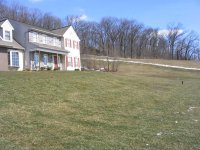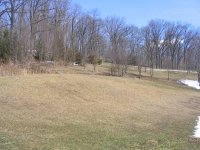RegL
Platinum Member
</font><font color="blue" class="small">( Suppose I do work at 30 degree slope or greater, what would happen? Would I damage the engine or hydraulics? Would there be symptoms to let me know something was amiss? )</font>
First symptom probably would be sledding to the bottom. I know you read alot of claims on the internet about operating on steep slopes but over 30 degrees is going to feel real scary on a 425. I have the 1430 and I don't think it would stay there, brakes or no brakes. Part of trouble is that, usually, the steeper the ground, the poorer the ground conditions as far as traction go's. The sod is usually weaker and it seems it,s either to wet or so dry that the soil crumbles under the tires.
Just an example of how steep we are talking, we have a ski jump here in town and the steepest part of the landing hill is about 35 degrees. The snow cat won't climb it unless we use a winch to help it along and i'm sure you have seen the amount of track a cat has on the ground. Imagine the little amount of rubber the PT has making contact. I love my PT but 30 degrees is to much to ask IMO.
First symptom probably would be sledding to the bottom. I know you read alot of claims on the internet about operating on steep slopes but over 30 degrees is going to feel real scary on a 425. I have the 1430 and I don't think it would stay there, brakes or no brakes. Part of trouble is that, usually, the steeper the ground, the poorer the ground conditions as far as traction go's. The sod is usually weaker and it seems it,s either to wet or so dry that the soil crumbles under the tires.
Just an example of how steep we are talking, we have a ski jump here in town and the steepest part of the landing hill is about 35 degrees. The snow cat won't climb it unless we use a winch to help it along and i'm sure you have seen the amount of track a cat has on the ground. Imagine the little amount of rubber the PT has making contact. I love my PT but 30 degrees is to much to ask IMO.


